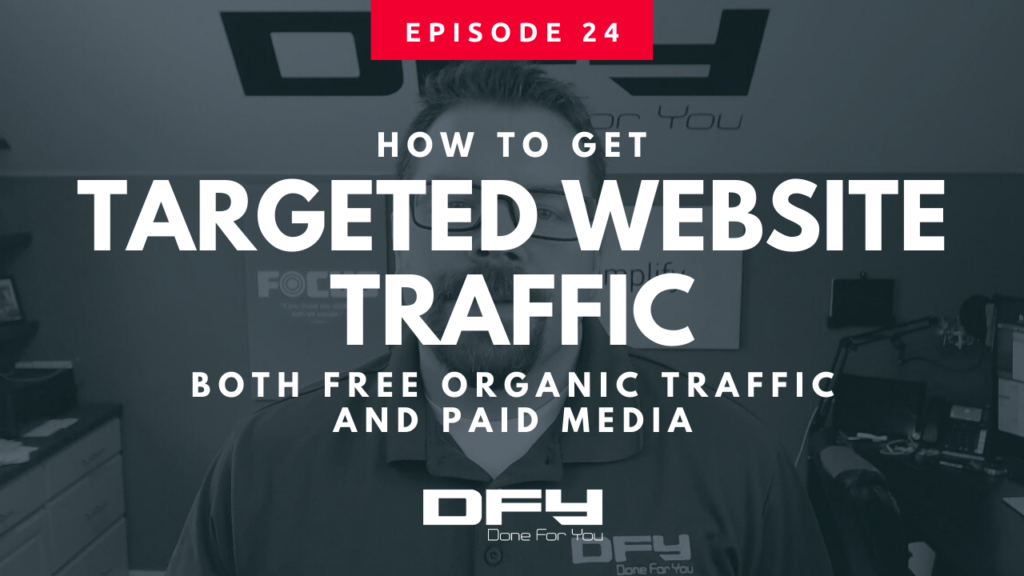At DoneForYou.com, clients often ask where to buy the best-targeted website traffic. As you may know, we provide done-for-you sales and marketing services since you're reading our blog. We help businesses acquire more leads and traffic and sell more to new and existing clients by leveraging technology and marketing and building automated online systems.
When we often work with a client to build their sales funnel, we also figure out the best new traffic sources to feed targeted visitors into their funnel.
That is why we get so many questions like:
- How do I drive free targeted traffic to my website?"
- What's the best place to buy quality, targeted website traffic?"
- How do I get more visitors from the US to my website?"
These are all valid questions given that every business wants more leads and clients; unfortunately, there's a veil that covers traffic generation tools, sources, and strategies. That is why we've put together this traffic generation Q&A article to lift the veil on traffic, debunk some common myths about targeted traffic sources, and save you some money you might waste buying fake traffic due to a lack of proper information.
Therefore, in this article about free and paid targeted traffic, we will answer all your traffic generation FAQs and more... Find anything missing. Shoot us a quick message on Facebook, and we’ll update this Q&A article automatically!
Where To Buy The Best Targeted Website Traffic For Your Sales Funnel

To begin with, let's briefly discuss why targeted website traffic is essential to a revenue-generating sales funnel. The purpose of having a funnel is to attract more leads, nurture them into qualified prospects, and finally convert them into paying customers. So, having targeted traffic, instead of generic visitors, coming you will be a resource saver. Not only will you spend less time and targeted visitors, but you will also have higher conversion rates and more sales in a shorter period.
Two Basic Types Of Website Traffic
But wait... What exactly is traffic? Put, web traffic is the internet users who visit your website. The higher the traffic volume, the more visitors your site gets. Accordingly, when you want to generate traffic, you want to attract more visitors to your website.
From a bird's eye view, there are two basic types of traffic: Paid and free.
Free traffic is when a visitor comes to your site in either of these two ways:
- finding your pages in Google search results or
- discovering your brand on other websites or social media.
Free traffic is often called organic traffic; sometimes, you can see it as search traffic or viral traffic.
Paid traffic is when you purchase...
- advertising space on others’ websites
- Search engine result pages (SERPs)
- ad clicks from social media or email lists
... of driving traffic to your site. You might hear this type of traffic referred to as PPC or SEM, among other terms.
How To Drive Free Web Traffic
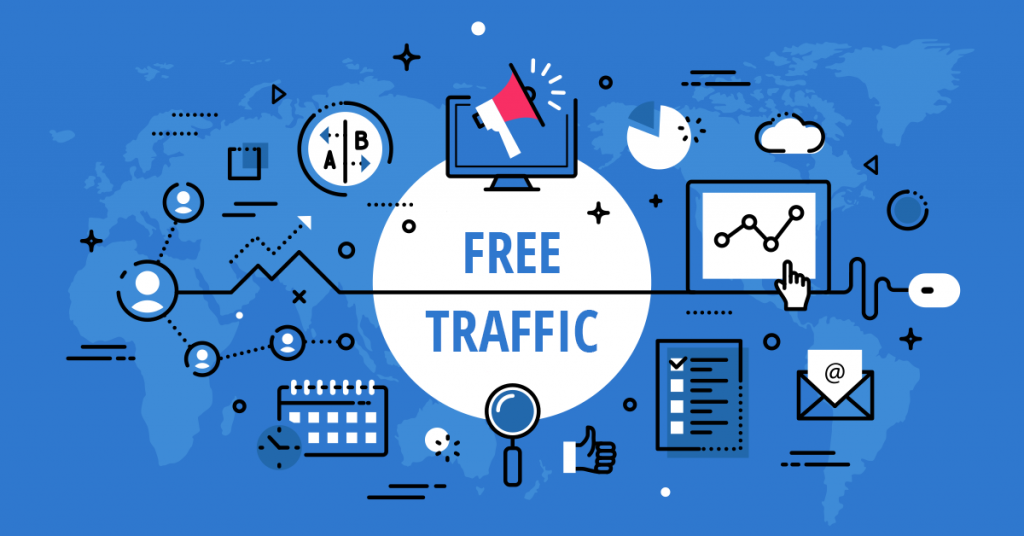
Turning to the actual ways to drive web traffic, a question we always get is, "How do I drive free targeted traffic to my offers?"
This is indeed one of the most popular questions.
Free organic traffic is arguably the best web traffic your web content must appear in SERP source for targeted leads. However, your web content must appear in SERPs to get to the point of a new visit.
But is this kind of traffic-free? Although you cannot buy organic visitors, you must spend money on content creation to rank on Google and eventually attract free targeted website traffic.
The myth lies in the idea that organic traffic has zero costs. This is not true. You do need to pay for content creation.
But what if you could create and publish content yourself? Wouldn’t that bring in free traffic? Well, yes, that's one way to look at it. Another way is that your time also costs money. So, traffic is not accessible because there is an opportunity cost involved.
So, why do people call organic traffic “free traffic?” That is because they do the work ahead of time to reap lasting results in the long run.
Similarly, when it comes to free viral traffic, meaning traffic from content that becomes popular on social media, you probably need to hire someone to create engaging content that will have a chance to go viral.
Creating good content might require an upfront investment; however, it paves the path for generating perpetual free targeted web traffic in the future.
Where To Buy The Best Website Traffic (And Why...)
This point takes us to the question, "Why is it a wise decision to buy web traffic?" Purchasing ad views or clicks is the best way to generate unlimited traffic quickly. Buying clicks is the fastest way to bring new visitors to your website.
While Search Engine Optimization (SEO) takes time to bear fruit, Pay-per-click (PPC) will immediately boost page views.
Our advice? Paid traffic is the way to go if you have the budget.
You can get clicks to your ads even on a small budget. We will look at how you can accomplish that further in this post, where we talk about inexpensive traffic.
If you're wondering where to buy the best-targeted website traffic fast, read this helpful guide to learn advanced strategies to help you scale your business with Facebook Ads. We will talk about where to buy the best website traffic down below...
First though...
Real human traffic vs. fake bot traffic
Before we dive further into answering more traffic FAQs, let us briefly debunk another myth. You might have come across sites that sell traffic or clicks, presumably from real human users on the internet. When you see advertisements such as these, you need to be cautious.
Some sites place your ad before the eyes of real people. So, for example, there might be a network of users who agree to receive email marketing messages. In return, they can send their email blasts to other users. This network is called a “safelist,” and the procedure is called “traffic exchange.”
Then, there are online services that promise to send you actual clicks, but what happens is that they use bots to emulate human behavior online. So, these bots, computer programs, in essence, click on your links and browse your sites as if they were human. That is why bots like that might appear in Google Analytics as real users, usually with a high bounce rate. Unfortunately, traffic scammers have improved in recent years. They can now deliver fake traffic with low bounce rates and seemingly accurate data, like source of traffic, country, type of browsing device and operating system, and more.
It would be best if you remembered that any service provider who cannot explain how they generate low-cost traffic is, in all likelihood, a con artist.
In brief, you should avoid spending your money on these types of services because, even if the users are real, they're not interested in what you offer. They're probably clicking on your links only to get some benefit as part of a safelist, and they won't pay attention to your offer.
Where To Buy The Best Targeted Website Traffic
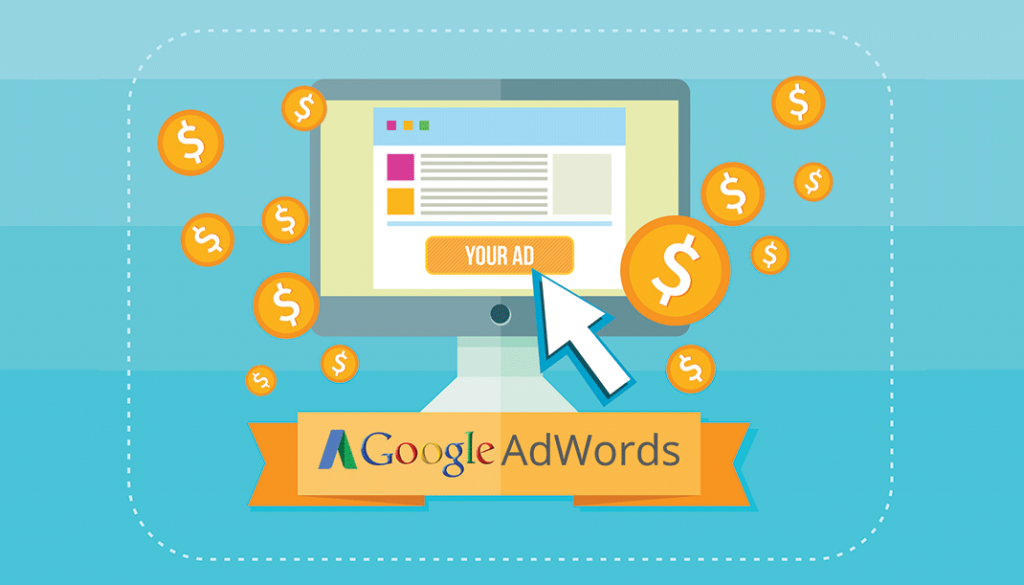
Now that we've cleared up the myth of “cheap clicks,” you are probably wondering where is a good place to buy website traffic.
There are different options. Let's look at the best places to buy targeted traffic that converts.
A. Google AdWords
Well, what can we say about Google? The search engine giant also dominates advertising.
A recent report estimates that Google and Facebook account for 73% of all digital advertising in the United States.
When setting up an ad on Google AdWords, you buy search or display traffic.
If you’re advertising for search, your ad will appear on SERPs when people search for your keywords.
On the other hand, display ads are mainly for displaying banners on third-party sites and for retargeting website visitors - meaning you'll have your ad shown to people who have already visited your site at least once.
Remembering that Google AdWords is one of the best ways to drive targeted traffic to your site would be best. Why? People who type in a search query are simultaneously expressing an interest in your keywords and intent before they finally click on your ads. If your business solves a high-ticket problem, Google is one of the best places if you're wondering where to buy targeted website traffic...
B. Facebook (and other social media)
Now, with social advertising, which is advertising on Facebook, LinkedIn, Twitter, and other networks, you also get targeted traffic, although it’s not search-based traffic. Who sees your ads on social media has to do with their demographics, profile, and declared interests. For example, you can target men aged 20-35 who have liked car-related business pages on Facebook. Or, you can target engaged women whose zodiac sign is Gemini.
“So, Google doesn’t have this kind of data?” you might ask. Of course, it does. With demographic targeting in AdWords, you can reach a specific subset of potential customers likely to be within a particular age range, gender, parental status, or household income. How does Google determine demographic information? Most people have a Google account, so Google knows more about their demographics and behavior than you would expect.
Compared to Facebook targeting, the difference is that you use demographics to narrow down your target audience. For example, while the trigger is a search query, you can filter out men from seeing your pregnancy yoga advertisement.
Another significant difference is that social advertising is still relatively cheap compared to Google Adwords. If you're on a small marketing budget, advertising on Facebook is an excellent alternative source of targeted traffic.
C. Outbrain/Taboola
Are you looking for alternative sources of affordable traffic? You know, sites where you can buy targeted website traffic off the beaten path? There are content promotion networks, like Outbrain and Taboola, which can help your business attract a targeted audience.
Content promotion networks (or content discovery platforms) work by displaying your ad on blogs and other sites with related content, usually below a blog post. In this way, services like Taboola enable advertisers to attract engaged audiences while, on the flip side, these networks give the ability to publishers to monetize their online properties.
D. Solo ads
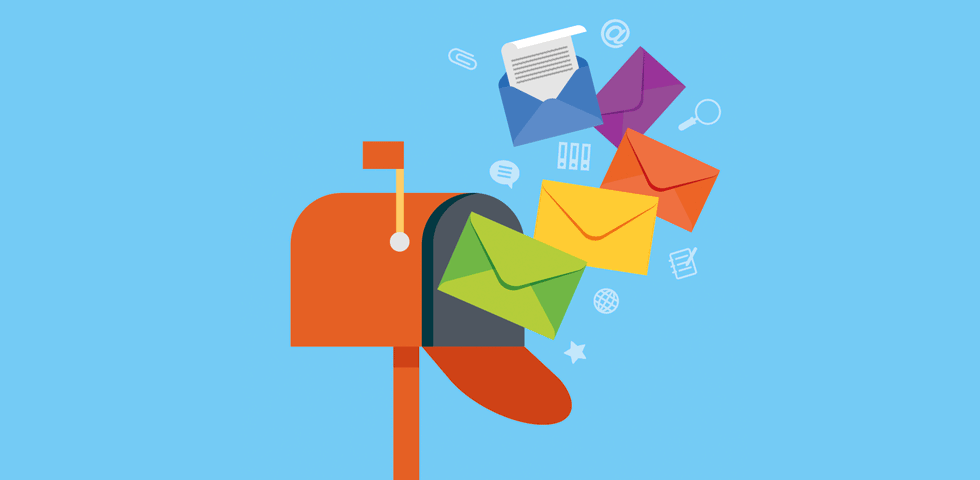
For marketers and business owners promoting products and services in niches such as...
- making money online
- network marketing
- MLM schemes
- Affiliate products
- business opportunities
...solo ads are arguably the best way to go.
You can do email marketing using other people’s lists with solo ads. How it works is that you have a lone ad provider email their subscribers with your email copy, and you pay them by the number of link clicks you receive from that particular email blast.
Solo ads can be an affordable way to draw targeted visitors to your offer, but not all isolated ad services are legit. Again, there are fraudulent services that use bots to deliver fake clicks. How do you go about finding high-quality solo ad sellers? The simple answer is real-buyer reviews. Visit sites like udimi.com, a marketplace for solo ads. There, you can see reviews from previous buyers under each seller’s listing.
We will give more ideas on how to find quality solo ads further down this article.
Where Is The Best Place To Buy Targeted Traffic?
Now that we’ve explained the primary sources of targeted web traffic, it only makes sense to talk about how you can choose the best traffic source.
First, the best way to generate traffic is to try and test different sources. It’s a good practice to distribute your budget across various advertising media so you can find out which one delivers the best results to your business regarding conversion rate and sales revenue.
However, we understand that trying out different traffic sources is not always possible. In this case, if you're looking for the best place to buy website traffic, we must say that there's no single answer. It heavily depends on your industry, goals, budget, and other factors. If we had to put together a list of the top places to buy the best-targeted traffic, we would rank Facebook Ads and Google AdWords on the top 2 positions on that list, though not in a particular order.
The best way to do it is to schedule a free strategy call with us to help you clarify your paid advertising options. As soon as we know more about your niche, product, and budget, we’ll be able to capitalize on our multifaceted experience and determine what traffic source would work best for your business.
How do I go about buying targeted traffic that converts?
Targeted traffic doesn’t always convert well. For example, people subscribed to solo ad lists might suffer from email promotion fatigue (meaning they are constantly bombarded with offers via email and are likely not opening certain kinds of emails anymore). So, in some cases, even if those subscribers click your solo ad link and land on your page, they won’t convert. They’ve seen so many similar offers and even bought some of them that they’re overwhelmed or disappointed from not seeing the promised results.
Where can you find the best targeted high-converting traffic?
Again, the answer lies in the two leading paid traffic sources, Facebook and Google. Other PPC sources, like Bing Ads and Yahoo Gemini, can also bring you quality traffic - note that these networks have a smaller audience reach than Google AdWords.
According to recent stats, Google controls nearly 75% of the search market, while Bing and Yahoo are between 5% and 10% each.
That is why the advertising cost per click is usually cheaper on Bing and Yahoo compared to Google.
Another factor you need to consider when buying the best-targeted traffic that converts is where your audience finds themselves in the buyer’s journey continuum.
Let’s briefly go back to theory and explain how people go through stages before buying your product. The steps of the buyer’s journey are awareness, interest, consideration, evaluation, and purchase. In these two articles How to Create Content for Every Stage of the Buyer’s Journey and How Content Marketing Drives Sales Throughout Your Buyer’s Journey we have explained more about these stages (although you might find some differences in the categorization) - and the point is this:
When you drive cold traffic to your offer, meaning visitors who have never seen anything about your brand before, it’s harder to drive conversions than to display your request to a warm audience. A friendly audience has come across your company's marketing material, and it’s even warmer if they interact with your brand.
So, a mistake you might make when looking to attract the best-targeted traffic is to expect a high conversion rate, even though these people have never heard of your brand before.
What you can do instead, if you want to see better conversion rates, is to deploy a sales funnel (also called marketing funnel) that will help to convert cold traffic into warm leads and advance people from the awareness stage to the evaluation and purchase stages.
PRO TIP: We run Facebook/Instagram, Google/Youtube, Linkedin, and Native Ad traffic for many different businesses and would love to help you! Click here to learn more!
What is the best web traffic source for targeted leads?
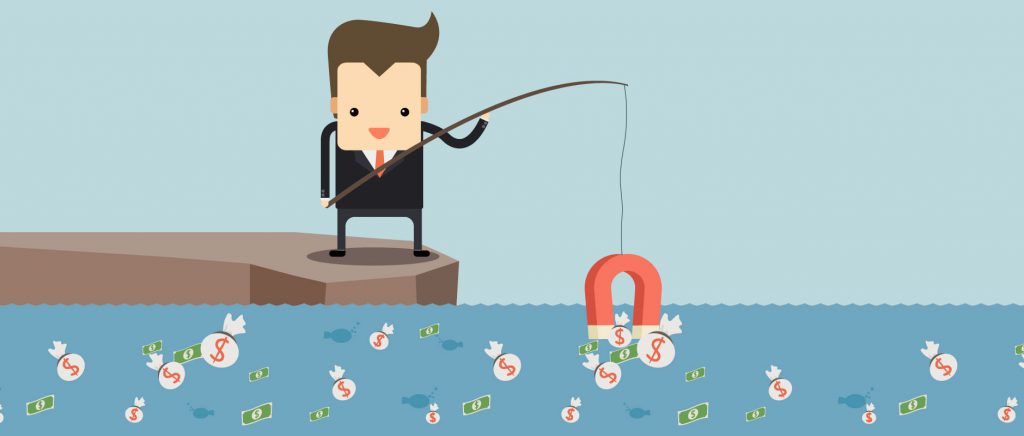
If your goal is not sales but leads, i.e., people interested in your offer who will subscribe to your mailing list, then cold traffic can convert well, given that your landing page is carefully designed. That's one of the big things people wonder where to buy the best-targeted website traffic.
For example, our templates you can find inside your Scriptly account have proven to convert at a rate of 42% to 54%, depending on the niche, which is excellent performance.
To summarize, concluding the best traffic source for targeted leads is tricky because it depends on your niche, budget, and product. To reiterate what we’ve said before, it would be Facebook Ads or Google AdWords if we were forced to pick the top finalists for generating paid leads.
I’m only shipping to the States. How can I advertise on a USA traffic website?
If you want to restrict paid traffic to USA traffic only, it is certainly possible. In the case of USA traffic, there is the option to limit the origin of clicks to your ads, whether you’re buying solo ads, search traffic, display ads, or social network ads.
In other words, all platforms and advertising networks allow you to choose where you want your web visitors to be.
Traffic from “rich” English-speaking countries might also be referred to as “Tier 1 traffic,” indicating the tendency to consider USA, UK, Australian, and New Zealand traffic of higher quality because, as most marketers would agree, people from Tier 1 countries spend more money online on average.
What are the best websites to buy quality traffic?
Another question we often get is, “What are the best websites to buy quality traffic?” We need to know two fundamental pieces of information before answering this question: What do you mean by “best websites” and “how do you define quality traffic?”
Then, we need to know what your business goal is. Are you trying to acquire more leads, or are you trying to drive instant sales? Then, the conversation might lead to “How much is a lead worth to you?” All these pieces of the puzzle will help us paint the picture of “What are the best websites to buy quality traffic?”
Again, the best way we can offer personalized help is to discuss your particular needs over a free strategy call, which will give you clarity about the best advertising strategy for your product.
Sometimes, the same question (“What are the best websites to buy quality traffic?”) comes from marketers promoting MLM or network marketing offers. Also, affiliate marketers might pose a similar question. In this case, websites as traffic sources might refer to solo ad marketplaces.
Many affiliates also visit Facebook groups where buyers post reviews of solo ad sellers. This way, you can see what others are saying about ad sellers, and you’ll be able to pick the ones who seem trustworthy.
Is there a way to buy website traffic using a free trial?
We recently received the above question and thought it was pretty strange. "Where to buy the best-targeted website traffic with a free trial?" What could that mean? The client said he wanted to try different paid traffic methods before taking hard out of pocket. Before spending money, he needed proof that the traffic system worked.
As explained earlier in this article, free trials and promises of free premium traffic are often a hideout for scammers.
There are con artists online trying to take advantage of legit business owners who want to drive quality traffic to their sites. These scammers use traffic bots, i.e., automated programs that open your page and are misinterpreted by Google as real visitors, although they’re just machines.
So, be careful when you read claims like “free premium quality traffic” unless you generate traffic from posting your content on social media.
Unfortunately, some people want to persuade you to believe that they’re sending real traffic to your site while all they’re doing is sending fake clicks.
Again, social media posting and engaging with your audience is an effective way to get free traffic. When coming across other supposedly free traffic methods, please be cautious and ask for proof.
It’s always better to invest your small budget in a traffic source you can verify (Facebook, for example) than to waste your dollars on something seemingly inexpensive that will cost you much more money, time, website reputation, and sanity.
How to buy cheap website traffic
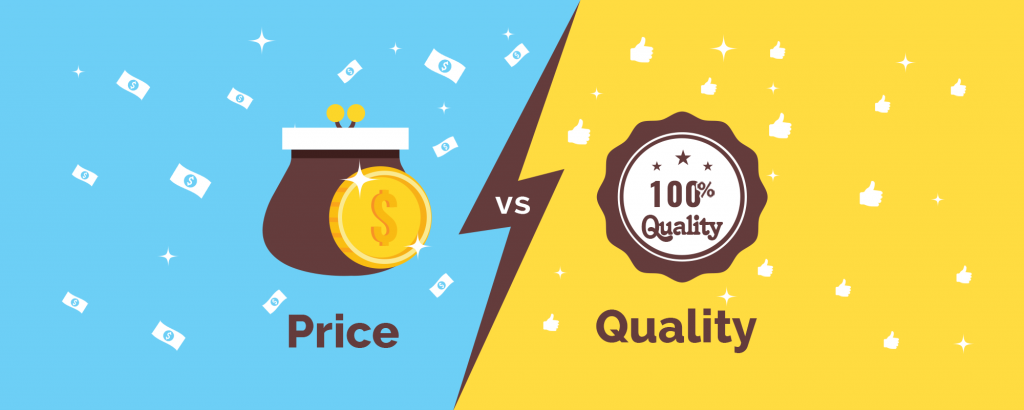
Low price might be your top deciding factor if you’re marketing your business on a small budget.
In our experience, Facebook is the best way for inexpensive website traffic.
How people understand the meaning of “inexpensive” is subjective. Different people mean different things with “cheap traffic.” Some affiliate marketers who run solo ads consider a $0.35 per click cheap. But what if y000 clicks and converts none of those into sales? What if the leads you get are “dead,” meaning non-responsive to your emails?
So, what “cheap website traffic” or “cheap targeted web traffic” really means is that you can attract web visitors and convert them into profitably paying customers. If you can’t make money from the traffic, “cheap” suddenly becomes “expensive.”
So, how do you know if your traffic drives profits? To be profitable
“Revenue Attributed to PPC” must be higher than “Total PPC Cost.”
Here’s how you can calculate those numbers - you can also find additional help in this article: Early-stage SaaS Startups Should Track These Important KPIs
CPC X Number of Clicks = Total PPC Cost
Number of Clicks X Customer Conversion Rate X Average CLV = Revenue Attributed to PPC
Here’s another post in case you want to learn more about handy metrics for paid advertising.
How to buy AdSense-safe traffic
This question comes from website owners who monetize their online properties using Google AdSense. You probably know that Google can be harsh with publishers who don’t conform to AdSense policies. If Google detects fake traffic to a website part of the AdSense network, it will immediately and irreversibly close that account.
With that in mind, the best way to go about AdSense-safe traffic is to invest in good, search-engine-optimized content, which will slowly but steadily attract organic traffic.
Our advice is to never buy website traffic with the sole purpose of getting ad clicks. It would be best to look at ad clicks as a byproduct of quality traffic.
How do I boost traffic to my website?
Now, whether you need to get a decent amount of ad clicks or a significant revenue increase, you must find ways to boost traffic to your website. We’ve written two solid articles on how to get more visitors to your site fast, and you can find them here and here.
In those articles, you will find actionable advice on instantly boosting your traffic, even if you have a newly built website.
How to generate traffic for an affiliate offer
Facebook doesn’t like affiliate marketers. Period. Why? Many affiliate marketers have abused advertising channels to drive traffic to deceiving offers, like push-button money-making methods and weight-loss programs with guaranteed results.
Having said that, if your affiliate offer abides by the advertising guidelines, there’s no reason you can’t use Facebook to drive traffic to your affiliate offers.
Also, note that many email marketing platforms will ban accounts for including affiliate links in their emails. AWeber is arguably the friendliest platform for affiliate marketers since it lets you have direct links to affiliate offers in your email copy.
So, how can you generate traffic for an affiliate offer without the risk of losing your email or ad account? Experienced marketers often create a written or video review of the software, course, or product they want to promote as affiliates. They also spice it up with valuable bonuses. Then, they use paid ads to drive traffic to that content.
Take Amy Porterfield as an example. Amy is open about being affiliated with Marie Forleo’s B-School, an exceptionally successful online program for people wanting to build an internet business. During annual B-School launches, Amy publishes content in different forms and on various media to increase sign-up to B-School for a chance to get a significant commission. Here’s an example of such content.
She’s even created a dedicated Facebook group to engage her audience further.
Here’s another excellent example of how you can promote affiliate offers - and this example comes from our posts. This post highlights the value of email marketing and the importance of choosing the best email marketing software. It provides an honest review and a comparison of different platforms, allowing visitors to sign up for those services via our affiliate links.
We hope these examples helped you get ideas on how you can promote affiliate products effectively. If you want to dive into more related content, here’s a post with ten ideas for promoting a digital product and another specifically for marketers who want to generate traffic for an affiliate offer.
Finally, this resource explains more about where to buy targeted website traffic.
How do I retarget USA visitors on my website?
Some of our clients, who have spent time educating themselves on traffic, often ask us about retargeting subsegments of web visitors.
Retargeting (or remarketing) is indeed pure gold; it’s essential to conversion rate optimization (CRO). In other words, to achieve the highest possible conversion rates from the same traffic volume, you must add retargeting to your marketing arsenal.
Before explaining how you can retarget USA visitors on your website, here’s a complete guide to CRO with retargeting.
Now, assuming a part of your incoming traffic is from the US, you need a way to retarget those people to promote a product that you ship to the US addresses only. Or perhaps simply because you want warm Tier 1 traffic returning to your site.
To do that, you can use either Facebook or Google paid advertising. Both services give you a tracking code (Facebook calls it a “Pixel”), which you must set up on your website before running retargeting campaigns. When the code is set up correctly, the advertising platform drops a cookie in the user’s browser. After this happens, you can retarget them. With retargeting, you can also narrow the target audience to include only people from a specific country.
Retargeting via AdWords
Here’s how it’s done in AdWords:
When you’re creating a new campaign, choose “Display”:

Then, in the next step, you’ll be asked about the campaign goal - and you can choose anything as long as it is a “Standard display campaign.”
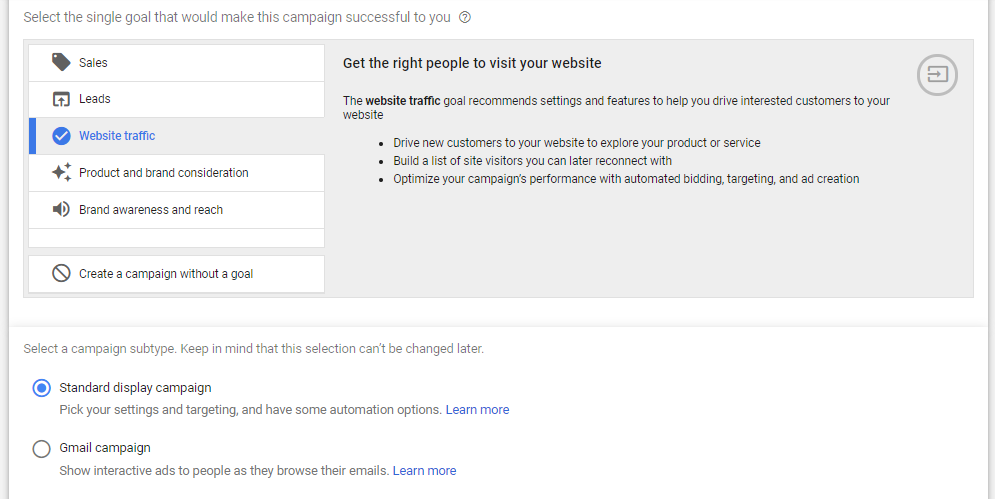
Then, on the next page, you’ll be given the option to choose what country you want to retarget…

At the bottom of the same page, you must choose "remarketing." That’s it.
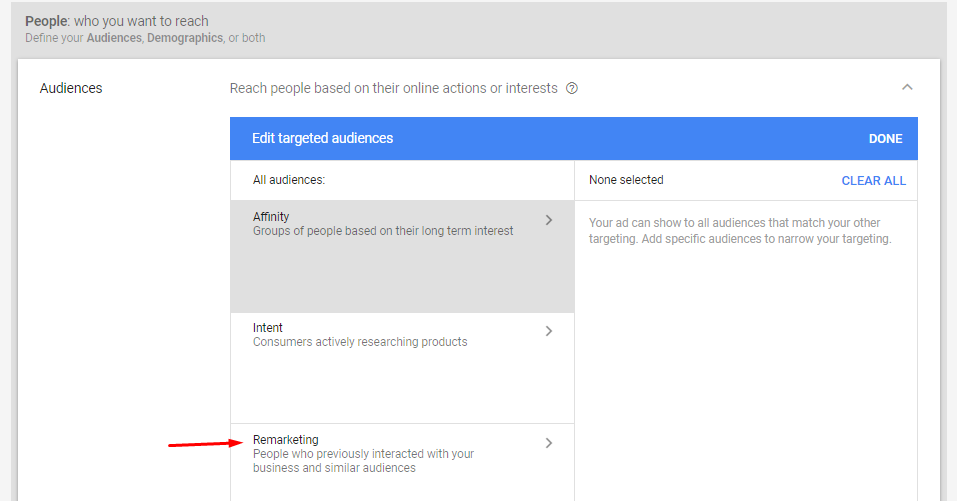
Retargeting via Facebook
If you want to retarget USA visitors on your website using Facebook Ads, then what you need to do on an Ad Set level is first to choose a custom audience and then the location.
Your custom audience will be extracted from your Facebook Pixel, and then by choosing a location, you can narrow down your remarketing audience to include US residents only.
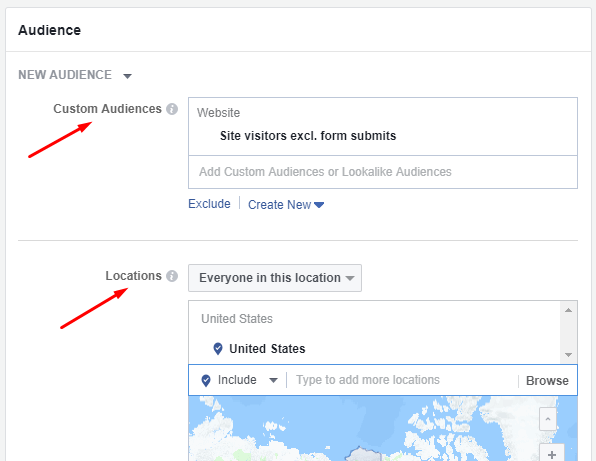
More web traffic questions?
So, that was it! A complete Q&A session about where to buy the best-targeted website traffic! We hope we answered your most pressing questions about free and paid traffic, how to get quality traffic fast, and how to choose the best source of targeted traffic for your business. We also gave you some tools and resources for further reading and the chance to book a free call with us to design your traffic generation strategy in a way that will bring measurable results.
Don’t forget to join us for a free webinar where we’ll show you how to convert a cold audience into hyperactive customers!
Have we missed something? Is there a traffic generation issue that we haven’t tackled? Send us your questions on Facebook, and we will update this comprehensive Q&A article to address your traffic questions quickly.
Are you looking for a complete, done-for-you marketing and sales solution? Read more about how we can help.
Or, if you'd like to get us to run your digital traffic, watch this video!
